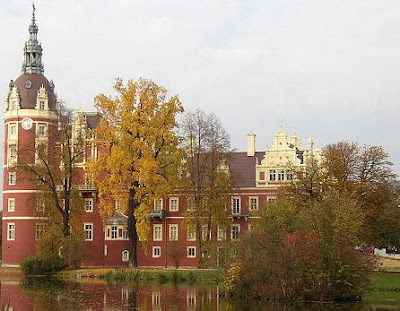The Muskau Park is the largest and one of the most famous English gardens of Germany and Poland. The Muskau Park is one of the UNESCO World Heritage Site in poland. It is also called as Muskauer Park, Furst Puckler Park and Park Muzakowski. The details of Muskau Park are explained in world tour guides below.
 Muskau Park is situated in the historic Upper Lusatia region, it covers 3.5 square kilometers or 1.4 sq mi of land in Poland and 2.1 km2 or 0.8 sq mi in Germany. The park extends on both sides of the Lusatian Neisse river, which constitutes the border between the countries. The 17.9 km2 or 6.9 sq mi buffer zone around the park encompassed the German town Bad Muskau in the West and Polish Lęknica in the East. While Muskau Castle is situated west of the Neisse, the heart of the park are the partially wooded raised areas on the east bank called The Park on Terraces.
Muskau Park is situated in the historic Upper Lusatia region, it covers 3.5 square kilometers or 1.4 sq mi of land in Poland and 2.1 km2 or 0.8 sq mi in Germany. The park extends on both sides of the Lusatian Neisse river, which constitutes the border between the countries. The 17.9 km2 or 6.9 sq mi buffer zone around the park encompassed the German town Bad Muskau in the West and Polish Lęknica in the East. While Muskau Castle is situated west of the Neisse, the heart of the park are the partially wooded raised areas on the east bank called The Park on Terraces.On July 2, 2004, the UNESCO inscribed the park on the World Heritage List, as an exemplary example of cross border cultural collaboration between Poland and Germany. It was inscribed to the list on two criteria for breaking new ground in terms of development towards the ideal man made landscape, and its influence on the development of landscape architecture as a discipline.
A fortress on the Neisse river at Muskau was first mentioned as early as in the 13th under the rule of Margrave Henry III of Meissen. The founder of the adjacent park was Prince Hermann von Puckler Muskau, the author of the influential Hints on Landscape Gardening and owner of the state country of Muskau since 1811. After prolonged studies in England, in 1815 during the time when the northeastern part of Upper Lusatia fell to Prussia, he laid out the Park. As time went by, he established an international school of landscape management in Bad Muskau and outlined the construction of an extensive landscape park which would envelop the town in a way not done before on such a grand scale.
The works involved remodelling the Baroque Old Castle actually a former castle gate - and the construction of a Gothic chapel, an English cottage, several bridges, and an orangery designed by Friedrich Ludwig Persius. Puckler reconstructed the medieval fortress as the New Castle, the compositional centre of the park, with a network of paths radiating from it and a pleasure ground influenced by the ideas of Humphry Repton, whose son John Adey worked at Muskau from 1822.

 The extensions went on until 1845, when Puckler due to his enormous debts was constrained to sell the patrimony. The next year it was acquired by Prince Frederick of the Netherlands, who employed Eduard Petzold, Pucklers disciple and a well-known landscape gardener, to complete his design. Upon his death in 1881, he was followed by his daughter Princess Marie, who sold the estates to the Arnim noble family.
The extensions went on until 1845, when Puckler due to his enormous debts was constrained to sell the patrimony. The next year it was acquired by Prince Frederick of the Netherlands, who employed Eduard Petzold, Pucklers disciple and a well-known landscape gardener, to complete his design. Upon his death in 1881, he was followed by his daughter Princess Marie, who sold the estates to the Arnim noble family.During the Battle of Berlin, both castles were levelled and all four bridges across the Neisse were razed. The Arnims were dispossessed by the Soviet Military Administration in Germany and since the implementation of the Oder Neisse line in 1945, the park has been divided by the state border between Poland and Germany, with two thirds of it on the Polish side. Not before the 1960s the Communist authorities slowly accepted the legacy of the Junker Prince Puckler. The Old Castle was rebuilt by the East German administration in 1965-72, while the New Castle and the bridges are still being restored.







No comments:
Post a Comment